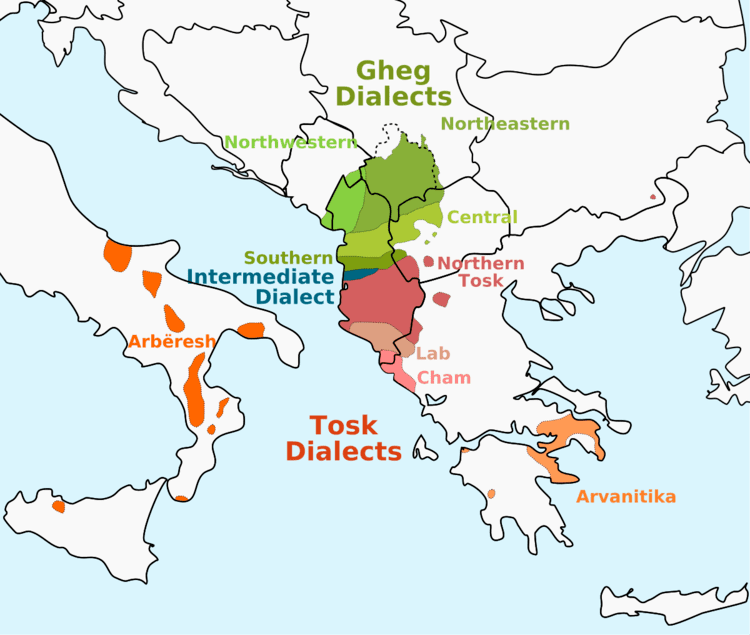 | ||
The Tosks are one of two major ethnic subgroups of Albanians (the other being the Ghegs) differentiated by their cultural, linguistic, social and religious characteristics.
Contents
Territory
Tosk may refer to the Tosk-speaking Albanian population of southern Albania, subgroups of which include the Myzeqars of Myzeqe, Labs of Labëria (name version in Albanian: sing: Lab, pl. Lebër, also dial. sing.: Lap; Greek: Λιάπης, Liapis) and Chams of Çamëria. The Arvanites of Greece and Arbëreshë of Italy are, mainly, descendants of Tosk-speaking settlers, as are the original inhabitants of the village of Mandritsa in Bulgaria. The name Toskëria itself is often used to name entire Tosk-speaking parts of Albania, in contrast to northern Gegëria.
The Tosks in Albania live indicatively south of the Shkumbin river. This region is widely referred to from foreigners as Toskeria (alb. Toskëri) The Ottoman Turkish term, used during the times when Albania was included in the empire, was Toskalık which is derived from Turkish language and means, belonging to Tosks.
Language
The Tosks speak Tosk Albanian, one of the two main Albanian dialects. The Albanian communist regime based the standard Albanian language mostly on Tosk Albanian. This practice has been criticized, notably by Arshi Pipa, who claimed that this decision deprived the Albanian language of its richness at the expense of the Ghegs, and referred to the literary Albanian language as a "monstrosity" produced by the Tosk communist leadership which conquered anti-Communist north Albania militarily, and imposed their Tosk Albanian dialect on the Ghegs. Although Albanian writers in former Yugoslavia were almost all Ghegs, they chose to write in Tosk for political reasons. This change of literary language has significant political and cultural consequences because the language is the main criterion for self-identification of the Albanians. Despite all efforts to unify Albanian language in some cases Ghegs from remote northern regions can not have conversation with Tosks from the further south.
Religion
Initially the population of Albania was Orthodox Christian, but in the middle of the 13th century the Ghegs were converted to Catholicism. Although many Tosks remained Orthodox Christians, the sense of strong division between Catholic Albanians and Orthodox Albanians did not evolve until the middle of the 18th century. Most Tosks are either Orthodox Christians or Bektashis in background. The Orthodox are more predominant in the regions around Gjirokastër, around Leskovik, and in the Myzeqe region (which includes the areas around Fier, Kuçova and Lushnja) and in the Dangëllia region (around Përmet) while Bektashis and are more heavily concentrated around Vlora, Tepelena, Pogradec and in Skrapar, Erseka and Gramsh. Other sects of Islam are present too, with Sunnis present mostly in cities and in far eastern regions (especially in Macedonia and Devoll) while there are also Halvetis in Berat. In almost all these areas, however, Christians, Bektashis and sometimes other sects of Muslims live side by side. Christians and Muslims were historically (around the time of the fall of the Ottoman Empire) almost evenly distributed in the Korça District and the area in and around the cities of Berat and Lushnja.
Culture and social organization
The Tosks maintained substantial contacts with outside world and were more influenced by it. Some authors believe Tosks are more progressive and open than Ghegs.
Tosks abandoned the tribal social organization by the end of 14th century and Ottoman conquest of the territory they lived. Tosks intermarried with non-Albanians more than Ghegs.
At the end of 19th and beginning of 20th century many Albanians migrated to United States and almost all of them were Tosks. There was also substantial migration of Tosks to Greece, particularly its northern part.
Physical anthropology
The Tosks have often been described as shorter, less slender and described as being of a darker Mediterranean type having a darker skin color than the Ghegs. The Tosks have smaller noses and rounder faces than Ghegs. Some claim that this difference has been reduced because of population movement in the period after 1992.
Pre-Ottoman and Ottoman period
There was a distinction between Ghegs and Tosks before the Ottomans appeared in Albania at the end of the 14th century. In the Ottoman Empire this division was additionally solidified because Tosks established strong cultural and intellectual connection with Istanbul and generally, the rest of the world.
Albania
In the 1920s Tosks were poverty-stricken peasants, still treated as serfs by their Muslim landlords. The Albanian Communist Party was basically established by Tosks who made up about three quarters of its membership. Before communists (Enver Hoxha and his fellow Tosks, such as Mehmet Shehu and Hysni Kapo) gained control over Albania its political life was dominated by Ghegs. At the end of 20th century the communists were overthrown and political life was again dominated by Ghegs. Ancient tensions between Ghegs and Tosks came to the forefront and resulted with riots of Tosks against the Ghegs' rule, whose symbol was Sali Berisha.
